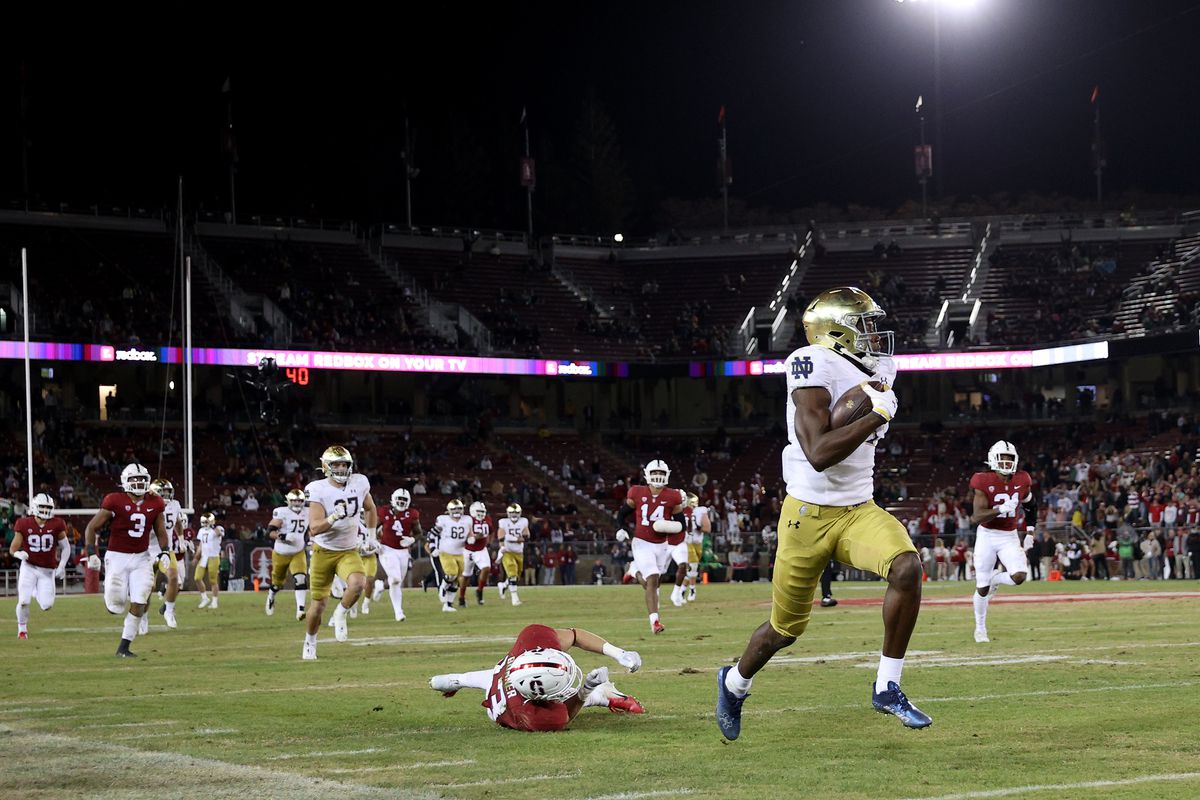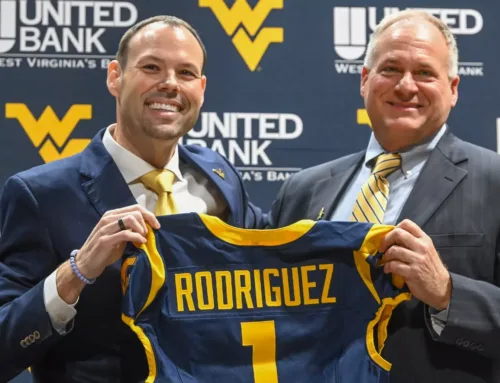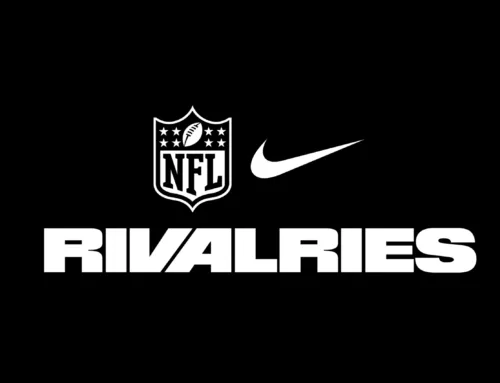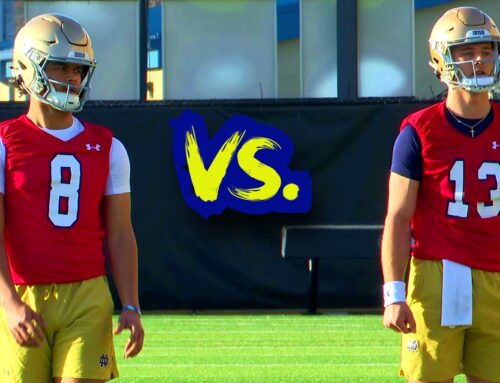A few weeks ago in this very space, with Notre Dame sitting at 1-2 after a shocking loss to Marshall and a drama-filled close win over Cal, we said the offseason warm fuzzies for the Freeman Era felt like “a distant memory.” Now the Irish are 3-2 after a sloppy but dominant win over North Carolina and thorough but messy win over then-#16 BYU, and we’re once again overwhelmed with wall destruction fantasies powered by pure charisma.
Our culture took over#GoIrish pic.twitter.com/vTbWP2tDe5
— Notre Dame Football (@NDFootball) October 9, 2022
It’s an emotional game… The big story of the last couple of games is that the offensive and defensive lines, both expected to be strengths preseason and both underwhelming initially, now look like they’re rounding into the form everyone thought they would take. If that trend continues, everyone left on the schedule is beatable (yes, I said everyone, embrace it). Far from a sure thing, certainly, and two key tests await in November, but there will be some mostly-cannon-fodder between now and then; first in line is the Stanford Cardinal, a program that’s a shell of its former powerful self. For the last few years their offensive line has been inconsistent at best and their defense has trended steadily softer and softer. They are without exaggeration one of the worst defensive teams in the country this year, particularly against the run. Their offense is a discombobulated mess and, while some of the pieces look decent, ultimately doesn’t do anything well enough to scare anyone. They can’t run the ball and they can’t protect the passer. They’re just… what’s the word? Bad. They’re bad.
And now they have to travel to South Bend to face an Irish squad that has solidified its identity as a team that will punch you in the mouth on offense and get after the quarterback on defense. It [chortling] looks like [giggling] it might be [guffawing] a very long day for the Tree [maniacal laughter].
Notre Dame (-17) vs. Stanford
Notre Dame Stadium
South Bend, IN
Date: Saturday, October 15th, 2022
Time: 7:30 PM ET
TV: NBC
Not a lot of positive to talk about for David Shaw’s charges this year. They’re not quite back down to the level of the Buddy Teevens and Walt Harris eras, but they’re not far off either. From 2011 to 2018, Shaw went 82-26 and won two Rose Bowls. Since 2019, Shaw has gone 12-23 for a 0.343 win percentage – still well ahead of Harris’s record in Palo Alto (6-17, 0.261) but only marginally better than Teevens’s (10-23, 0.303) – and hasn’t appeared in a bowl game, let alone won one. They’re 1-4 so far this season with the one win coming against FCS Colgate. They’re a three score dog in this game, as noted, and it’s not out of the question that they could be the betting underdog in all their remaining games – vs. Arizona State, at #11 UCLA, vs. Wazzu, at #20 Utah, at Cal, vs. BYU. They may be a small favorite against Arizona State and/or Cal, but they’re a virtual lock to be underdogs to all the others.
I’m not saying a 1-11 record is in play, but I’m not not saying it either, you know? They have a ton of holes on both sides of the ball and it’s not likely to get better anytime soon, as their recruiting has fallen off a cliff. Starting with the 2018 class, which would be the current fifth-years, their year-by-year class rankings are 40th, 21st, 22nd, 48th, and 27th. They have precious little star power in the pipeline and few if any diamonds in the rough to make up for it. Not surprisingly, that has shown on the field as they now take a talent deficit into many of their games; Oregon State’s last minute score last weekend resulted in Stanford’s eleventh consecutive loss to an FBS opponent, which is the longest such active streak in the country. The average margin in those eleven losses is 18.6 points.
They can’t run the ball (79th in yards per carry), can’t protect the passer (121st in sacks per game), can’t stop the run (126th in yards per carry allowed), and can’t cover (106th in passer rating allowed). They’re dead last nationally (131st) in turnover margin at -11. They’re good at covering kicks (1st in kickoff return average allowed, 40th in punt return average allowed) but not so hot at returning it themselves (59th and 118th). Their offensive system is known formally as “slow mesh” (think the takes-forever 2018 Wake Forest offense) but is better described as “grab bag” given how well they run it. Their defense is best described as “soft.” There are a handful of Stanford fans who are upset about it (just kidding, there’s one, and he’s moderately annoyed), Shaw shows minimal effort on the recruiting trail and minimal interest in changing things up with his staff or his approach, and nobody in the Stanford administration particularly seems to be bothered by any of it.
TL,DR: They’re bad at everything and Shaw doesn’t care and isn’t going anywhere.
Hate to see it.
Stanford’s Offense
They’ve put up some points and yards but most of their production has come in the second half of games, when USC (41-14 through three quarters), Washington (30-7 through three), and Oregon (38-10 late in the third) eased up in garbage time. It’s not quite as bad as the defensive picture but the overarching theme is the same – they’re not particularly good at anything and have struggled to do anything with any consistency. Which, you know, is how you lose eleven in a row against FBS competition.
They have a few skill position guys, most notably QB Tanner McKee (#38 overall in the 2018 class), WR Michael Wilson (#241 in 2018), WR Elijah Higgins (#85 in 2019), and RB EJ Smith (#109 in 2020 and Emmitt’s kid), but they’ve mostly been good-not-great – and to make that worse, Smith recently went down for the season with an unspecified leg injury that required surgery. McKee and Wilson have been relatively bright spots for the Stanford offense, although Wilson has been Jekyll and Hyde this season – he had six catches for 176 yards and two scores against Washington, five catches for 82 yards and two scores against Colgate, and six catches for 94 yards and no scores against USC, Oregon, and Oregon State.
The running game has struggled mightily since losing EJ Smith after the USC game; Smith accounted for just under 30% of the Cardinal’s total yardage from scrimmage in their first two games. Junior Casey Filkins has filled in as an adequate option, sort of a Christian McCaffrey Lite, but he can be contained – as is suggested by his 4.1 yards per carry average. The other three healthy backs have a total of 16 carries for 57 yards. They complement the running backs with an occasional give to Wilson, Higgins, or tight end Ben Yurosek; Yurosek had one carry for 50 yards against USC, Wilson has had one in each of the last three games for a total of 30 yards, and Higgins had one for 18 against USC. They don’t do it often but you can count on it once or twice a game, so it’s something to watch for.
In the passing game, Wilson leads the team in receiving yards but the ball has been shared pretty evenly between him, Higgins, Yurosek, Filkins, and Brycen Tremayne; all have logged between 12 and 19 receptions on the season. Wilson is the most dangerous option by far, with 17 receptions and an average of 20.7 yards per to go with a team-leading four touchdowns, while Yurosek and Higgins are possession receivers. Tremayne may have emerged a little bit against Oregon State, inasmuch as that’s possible, as one of the typical Stanford power forward/receiver mashups – the 6’4″, 212 pound wideout had six catches for 82 yards and two scores. He was a non-factor in their first four games, so that’s another potential development to watch.
At the heart of their issues is, shockingly for those who remember the late Harbaugh/early Shaw halcyon days, the offensive line. The offensive line is a bit of a mess, with its issues compounded by injuries and a general lack of talent. Stanford signed just two top 250 offensive linemen combined in those five 2018-22 classes – current starting right tackle Myles Hinton (#74 in 2020) and recent medical retiree Branson Bragg (#125 in 2019). Bragg was supposed to start on the interior, while Hinton, starting left tackle Walter Rouse, and sixth man Barrett Miller have all missed time with assorted health issues. The line’s issues have come home to roost through the air, where as noted they have big problems keeping McKee clean – in their three games against above-average opponents they allowed five sacks to USC, eight to Washington, and three to Oregon – and on the ground, where they rank 79th in yards per carry on the season and have averaged 3.1 per carry since Smith went down.
Stanford’s Defense
Now, having said all that… Their defense makes their offense look good in comparison. If the Equator is average, their offense is in Bolivia and their defense is getting in a boat in Tierra del Fuego. Here are there national rankings in several major defensive stats – and keep in mind that these include a season opener against an FCS team that has since gone 1-3 against other FCS teams:
- 110th in scoring defense at 32.8 points per game
- 122nd in yards per play allowed at 6.54
- 126th in yards per carry allowed at 5.63
- 106th in passer rating allowed at 145.43
- 91st in yards per passing attempt allowed at 7.7
- 110th in total defense at 431.6 yards per game
- 101st in tackles for loss with 27
- 61st in sacks with 12 (more on that in a bit)
- 112th in passes broken up with 13
- 108th in interceptions with 2
- 122nd in fumbles forced with 1
- 129th in fumbles recovered with 0, the only program not to have at least one yet
- 104th in 40+ yard plays allowed with 8
Situational stats are kinder to them – they’re 30th in third down conversion rate allowed (31.82%) and 27th in red zone touchdown rate allowed (47.37%) – but they’re so bad everywhere else that it’s the quintessence of lipstick on a pig. If you ask me to highlight something they can do reasonably well… I can’t, and I promise that’s not just my extensive reserve of Stanford Haterade speaking. They’ve shown some ability to get after the quarterback with four sacks in each of the USC and Oregon State games, but that ability also vanished in games against Washington and Oregon, in which they had one sack total. Colgate and Oregon were the only teams they really prevented from hurting them through the air, and even with Oregon it didn’t matter because they got absolutely destroyed on the ground to the tune of 351 yards on 37 carries. That’s not a typo, Oregon really did hit almost 10 yards per carry.
In fact everyone was able to find a fair degree of success on the ground against them, even Colgate – sacks excluded, they ran 36 times for 174 yards, a 4.8 per carry average. Colgate has averaged 4.5 yards per carry, sacks excluded, in their four games against FCS opponents if you were wondering, and if you weren’t wondering I was going to say it anyway because it’s fun. Yes, that’s right, the Raiders ran slightly better against Stanford than they did against Maine, Penn, Holy Cross, and Cornell. Res ipsa loquitor.
True freshman David Bailey, a top 100 recruit, is their most disruptive player with 4.5 tackles for loss. He’s a nascent dude and must be accounted for. The rest of them… Eh. Senior ILB Levani Damuni led the team in tackles last year and leads again this year, but he’s more of a steady presence than anything else. Their second and third leading tacklers are Kendall Williamson and Oklahoma transfer Patrick Fields, both senior safeties. It’s not necessarily a bad thing to have both safeties in the top three tacklers on your defense, but given the other context around this defense it’s not great. They have a couple of guys who can get after it a little bit – senior ILB Ricky Miezan, junior DL Tobin Phillips, and senior DE Stephen Herron have all flashed now and then – but across the board they’re just not much there that would force an offensive coordinator to change a game plan.
Prediction
This sets up as a matchup of two teams headed in very different directions. Marcus Freeman’s squad has apparently weathered an early storm and righted the ship in definitive fashion over its last couple of games while David Shaw’s program is circling the drain and nobody can be bothered to even pull an alarm over it. The 2022 Irish are by no means a finished product, and that perhaps is where the greatest opportunity and risk lies in this game. Sixty minutes of focused performance from the Irish should leave little doubt about the outcome of this game, but we’re not quite at the point where we can assume that will happen. On the flip side, Stanford should – emphasis on should – play with desperation given that a loss would almost certainly set them on course for a second consecutive 3-9 season.
Key questions:
1) Will Notre Dame play sixty minutes of focused football? The offense showed signed against Cal and then showed large stretches of very effective play against North Carolina and BYU, but it also came up short at a couple of key junctures in those games that could’ve turned them into much more relaxing affairs. On its final two possessions against Cal, the offense managed only eight plays for 16 yards while taking only four minutes off the clock. Against North Carolina, a late third quarter drive ended in a turnover on downs when Drew Pyne’s sneak went nowhere and a potentially soul-crushing touchdown drive turned into an end zone fumble with just over three minutes left. Against BYU, the first fourth quarter drive ended in an interception deep in BYU’s territory and the second ended in a field goal after first and goal from the seven. The defensive lapses late in games have been well documented. Notre Dame has started to dominate the second and third quarters – can it turn the screws in the fourth?
2) Will young players get a chance to get some experience? Segueing from the last question: If Notre Dame can take care of business, this game shouldn’t be close. If this game isn’t close, younger and/or more inexperienced players can get some much needed experience against live bullets. Steve Angeli will almost certainly be needed for at least a handful of meaningful plays this year and in any case is one big hit away from being the starter – his first action can’t come in a big spot. Tobias Merriweather would benefit from live action. Jordan Botelho is stuck behind Isaiah Foskey and Justin Ademilola, but both will be gone next year and he could use some playing time before then. With the Jacob Lacey transfer, it’s critical for Gabe Rubio and Aidan Keanaaina to get up to speed for next season at least if not sooner. Prince Kollie and Junior Tuihalamaka might shine. Etc. etc.
3) Does anyone at Stanford care enough to be desperate for a win? Since Shaw went 4-8 in 2019, he has made a total of one – one! – staff change, and even that wasn’t initiated by him. After the 2019 season inside linebackers coach Peter Hansen took the UNLV defensive coordinator job and Shaw hired NFL defensive assistant Eric Sanders to replace him. That’s it. As the team went 4-8, 4-2, 3-9, and now 1-4 in this season with 3-9 or worse firmly in the picture, the coaching staff has remained almost entirely unchanged. Judging by the conversation on Stanford message boards – yes, there are a couple, but I’m not entirely sold that all the posters aren’t just one guy going through various schizophrenic episodes – there’s little if any momentum within the administration to even make Shaw’s seat slightly toasty let alone actually warm. Details of his contract are nigh impossible to find but his buyout at this point is rumored to be around $30M, which I would imagine does little to increase the administration’s motivation to replace him. I’m sure he’d rather win than not win, but he seems to be about as disinterested as a coach could possibly be in actually doing anything about it. On the players’ side, no doubt they’re all highly competitive people but that attitude at the top and the general weight of losing starts to filter down to everyone. Like I said above, they should be desperate for a win and come out ready to fight. I just don’t know that they will be.





Great preview Brendan. Hopefully this will be as satisfying of a game as it has the potential to be. Stanford truly is in a sorry state now, not sad at all for them mind you, but it is really something how much they have fallen off.
And who the hell thought it was a good idea to make this a night game? Harumph! Dinner in Chicago, ruined!
Blowing out Stanford but you don’t wanna stay up until 2 AM finishing the game review when the kids will have you awake at 6 AM.
Take the night off, man. We’ll all know what happened.
That’ll be next weekend when I’m in California for a few days during the mighty Running’ Rebels matchup.
I love that this is a night game. Notre Dame Stadium has lived rent-free in David Shaw’s head since 2012, and anything that makes the venue colder, darker, and louder is good for us. I genuinely think playing in South Bend makes Shaw a worse coach because he’s so focused on the noise level and the phantom whistles and so on and so on.
Fun fact: Shaw is 1-3 at Notre Dame and has never beaten a ND team with a winning record in South Bend.
Blow them out. Run up the score. I don’t ever want to hear David Shaw whining about the 2012 game ever again. I want to hear him whining about how in 2022 Steve Angeli threw 2 TDs while ND was already up 40.
Hey, they put their pants on the same as everyone else!
More like ass-pirational peers if you ask me. ND 38-14.
Oh that’s excellent.
I confer upon you the degree of ShD – Doctorate of Stanford Hateration. Welcome to the fraternity, my brother.
i humbly accept this great honor
After the BYU game I was feeling more optimistic about this being the game where ND finally plays well for four quarters, but it seems more likely that we just grind out a 28-17 win where we’re up 21-10 in the third quarter and then allow a 70 yard TD pass to someone totally uncovered and never put in any young offensive players.
1) Will Notre Dame play sixty minutes of focused football? – No
2) Will young players get a chance to get some experience? – No
3) Does anyone at Stanford care enough to be desperate for a win? – No
ND 28 – Stanford 17. Looking forward to the in-stadium show between the third and fourth quarters. It was pretty good for the night games last year even when they were trying to shoehorn Jump Around into it.
If we can’t score twice in the first quarter tomorrow night, it’s probably not going to happen at all this season.
UNLV did play Cal close but they also just lost 40-7 to San Jose State, so hopefully not so fast my friend. Navy is also a very confounding team to figure out, they are not good, yet they demolished Tulsa. Not sure who that says more about right now, but that should be another opportunity in a perfect world for mop up duty for younger players.
You’re def right though that this game should be the golden chance to not have to sweat for 60 minutes and get some playing time for the reserves. It would be depressing if gambit’s scenario is reality, which sadly might be close to accurate.
I am not going to believe that, though, I’m saying 38-10, maybe 38-17 with garbage time and a fairly easy win running away and some depth players get the chance for game action.
Completely agree. I think tomorrow will really depend on whether Stanford gives up, and how quickly. If they fight all the way to the end, I think gambit’s scenario will probably be right. If they throw in the towel early, we could get to like 45-10 territory.
I am going to a wedding tomorrow and was pretty excited that it started at 7. I assumed crappy Stanford @ND would be a nice little 3pm game. I personally would have scheduled it for noon just to mess with them. I’m thinking, sure, maybe I miss some mop up and Merriweather’s first 3 TDs, but not terrible for a fall Saturday.
Then I go and read this and am decidedly not happy. Why would you do this to me????
McKee got any eligibility left? The one aisle we can shop down has some players we could really use. I’d take McKee, 1-2 of their WRs, and that young DE.
I am 100% on board with ganking Stanford and Northwestern’s best players via the transfer portal every year and watching Shaw and Fitz fume helplessly.
Stanford represents my favorite example from my “ND Embarrassment Karmic Retribution” Theory, which is that embarrassing ND in the regular season means bad things for your team going forward. 2016 USC? Program tanked for 5 years. 2017 Miami? Immediately fell apart, still suck. 2017 Stanford? Promptly lost the PAC12 Championship and their bowl game, have since fallen off a cliff. 2019 Michigan? Went 5-6 over the next year+ (sadly recovered). Not sure if this is still in effect in the Freeman Era, but since Ohio State didn’t embarrass us they’re not eligible anyway.
I like that theory and would subscribe.
Also, the Marshall loss could be considered the most embarrassing of them all (though not for being a blowout, but just losing to them period) and Marshall hasn’t been able to avoid the retribution either. They’ve lost 3/4 games played since, and I believe they were favored to win each of those games too.
.

Time to consider participation and who do you redshirt. Stanford, UNLV, Navy, BC are left on the schedule. Which Seniors will move on. Which walk-ons to play.